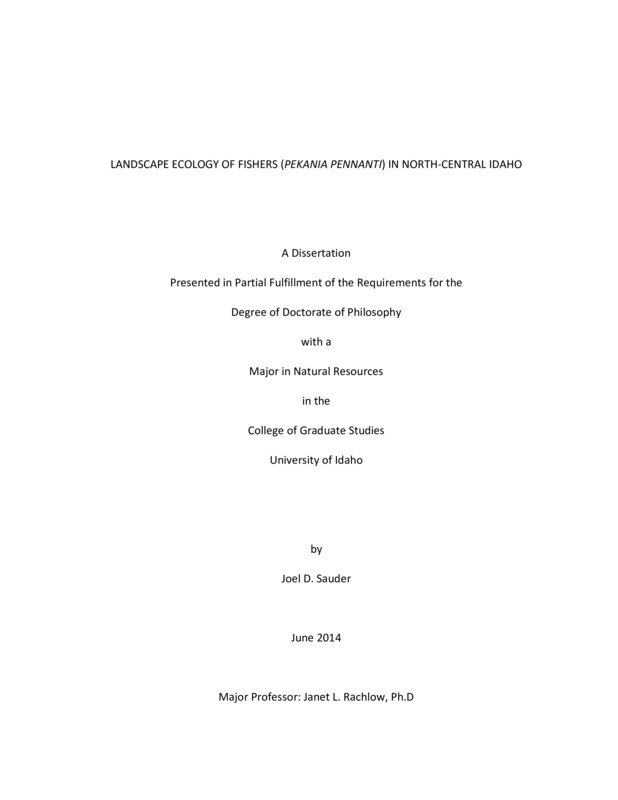LANDSCAPE ECOLOGY OF FISHERS (PEKANIA PENNANTI) IN NORTH-CENTRAL IDAHO
Sauder, Joel David. (2014). LANDSCAPE ECOLOGY OF FISHERS (PEKANIA PENNANTI) IN NORTH-CENTRAL IDAHO. Theses and Dissertations Collection, University of Idaho Library Digital Collections. https://www.lib.uidaho.edu/digital/etd/items/sauder_idaho_0089e_10215.html
- Title:
- LANDSCAPE ECOLOGY OF FISHERS (PEKANIA PENNANTI) IN NORTH-CENTRAL IDAHO
- Author:
- Sauder, Joel David
- Date:
- 2014
- Keywords:
- fisher habitat selection landscape ecology martes pennanti pekania pennanti
- Program:
- Natural Resources
- Subject Category:
- Wildlife conservation; Wildlife management
- Abstract:
-
The fisher (Pekania pennanti) is member of the mustelid family and is endemic to the northern forest of North America. It occurs at low densities, uses large landscapes, is generally associated with late-seral forest characteristics, and is of conservation concern. We examined space use and habitat selection by fishers across multiple scales in north-central Idaho with the goal of providing increased information for forest managers to map and integrate the habitat requirements of fishers into forest management plans. We used Argos satellite telemetry to monitor the movements of fishers and demonstrated that the locational accuracy and data collection rates of this telemetry technique are robust to the effects of varying topography and canopy cover. Overall, fishers selected landscapes for home ranges with larger, more contiguous patches of mature forest and reduced abundances of open forest. This result supports the hypotheses that both forest configuration and composition influence the distribution of fishers in north-central Idaho. Additionally, within home ranges, fishers selected areas for core use zones that had higher fine-scale habitat heterogeneity than peripheral use zones. This result supports the hypothesis that fishers establish home ranges that include a diverse array of forest conditions, thereby increasing their access to a greater diversity and abundance of prey species while still attaining access to habitat features that are important for reproduction and thermoregulation. Finally, and most importantly, we synthesized the results from our analyses at the landscape and intra-home range scales with a previously published study on the distribution of fishers across the Rocky Mountains of Idaho and Montana. In doing this, we produced an integrated, multi-scale habitat selection model that had improved predictive accuracy over the most detailed single-scale model available. Almost 80% of the predicted habitat for fishers in Idaho and Montana occurs on federally owned national forests, yet only 28% occurs in wilderness or roadless areas. Consequently, successful conservation of fishers will rely heavily on policy and management decisions made on landscapes managed under multiple-use principles as wilderness and roadless areas alone are unlikely to provide sufficient habitat or population reserves to ensure persistence of fishers in Idaho and Montana.
- Description:
- doctoral, Ph.D., Natural Resources -- University of Idaho - College of Graduate Studies, 2014
- Major Professor:
- Rachlow, Janet L
- Committee:
- Garton, Edward O; Vierling, Lee A; Melquist, Wayne E
- Defense Date:
- 2014
- Identifier:
- Sauder_idaho_0089E_10215
- Type:
- Text
- Format Original:
- Format:
- application/pdf
- Rights:
- In Copyright - Educational Use Permitted. For more information, please contact University of Idaho Library Special Collections and Archives Department at libspec@uidaho.edu.
- Standardized Rights:
- http://rightsstatements.org/vocab/InC-EDU/1.0/

